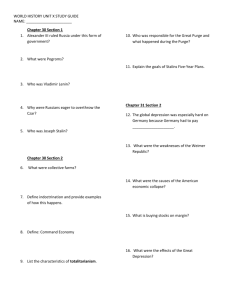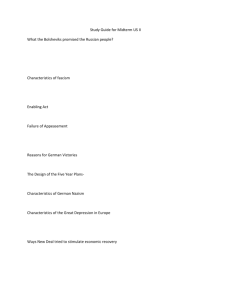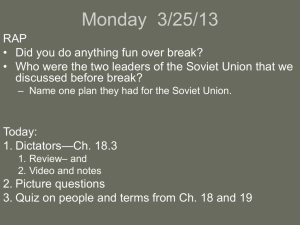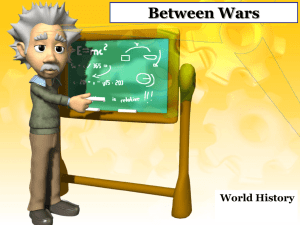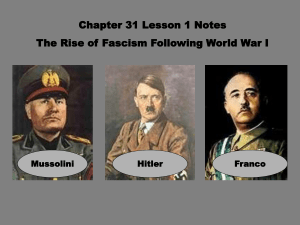Rise of Totalitarianism
advertisement
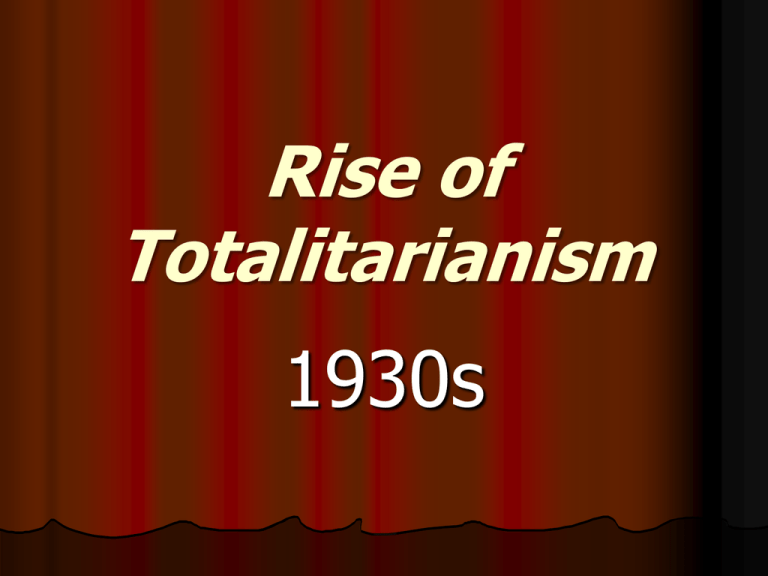
Rise of Totalitarianism 1930s Totalitarianism A government that controls or attempts to control the totality of human life and expects complete loyalty to the state and leader. Totalitarian Governments Germany – National Socialist German Workers Party (Nazis) Italy – Fascist Party Soviet Union – Communist Japan – Emperor What Lead to the rise of totalitarian governments? Treaty of Versailles Economic hardship Political instability League of Nations Treaty of Versailles Treaty humiliated Germany. Destroyed her economically. Italy felt cheated out of land they were promised. Economic Hardships WWI left most countries in deep debt Great Depression felt worldwide Trade between nations dropped Many out of work Political Instability Most lost faith in the democratic governments set up after the war. The democratic governments failed to solve economic, social, and political problems. This allowed for socialist and communist groups to gain support. League of Nations League of Nations was weak Failure to check aggression and preserve world peace contributed to the rise of totalitarian regimes. Japan, Germany, and Italy all committed acts of aggression. Fascism Fascism was a new, militant political movement that emphasized loyalty to the state and obedience to its leader. Fascism After World War I, millions of people lost faith in democratic government. In response, they turned to an extreme system of government called fascism. Fascists promised to revive the economy, punish those responsible for hard times, and restore order and national pride. Their message attracted many people who felt frustrated and angered by the peace treaties that followed World War I and by the Great Depression. Fascism vs. Communism Differences Fascism Extremely nationalistic (Fascism is for the good of a particular country alone.) Does not seek a “classless society”. Made up of aristocrats, industrialists, war veterans, and lower middle class. Communism Internationalistic (Communists believe their system should spread throughout the world.) Seeks a “classless society” Made up of urban working lower classes (Russia) and peasants (China). Fascism AND Communism Similarities Both were ruled by dictators. Both allowed only one-party rule. Both denied individual rights. In both, the state was supreme. Neither practiced democracy. Both replaced religion with some kind of competing belief system (atheism—in the case of the communists; religion of racial superiority—in the case of the Nazis) Cultural • Censorship • Indoctrination • Secret police Social • Supported by middle class, Industrialists, and military Chief Examples • Italy • Spain • Germany Fascism Political • nationalist • racist (Nazism) • one-party rule • supreme leader Economic • economic functions controlled by state corporations or state Basic Principles • authoritarianism • state more important than the individual • charismatic leader • action oriented Mussolini Takes Control Fascism fueled by Italy’s failure to win large territorial gains at the Paris Peace Conference. Inflation and unemployment fuel Fascism. Mussolini promised to rescue Italy’s economy and rebuild armed forces. Mussolini founds the Fascist party in 1919. Economic downturn makes Fascists popular. March on Rome October 27-29, 1922 Fascist “blackshirts” march on Rome an demand that King Victor Emmanuel III put Mussolini in charge of the government. He puts Mussolini in power “legally.” Il Duce’s Leadership Mussolini was now called “Il Duce” translated “the leader. Democracy was abolished along with all opposing political parties to the Fascists. Secret police jailed political opponents. Il Duce’s Leadership Radio and publications were forced to broadcast or public Fascist teachings. He sought to control the economy by allying Fascists with industrialist and large landowners. Fascist Flag The original symbol of Fascism, in Italy under Benito Mussolini, was the fasces. This is an ancient Roman symbol of power; a bundle of sticks featuring an axe, indicating the power over life and death. through unity. Hitler Rises to Power in Germany Adolf Hitler’s early life had been marked by disappointment. When World War I broke out, Hitler volunteered for the German army and was awarded the German Iron Cross for Bravery. Adolf Hitler The Rise of the Nazis He was appointed to investigate a small political party known as the “German Workers Party.” Hitler was impressed by the party’s leader and joined the group. The group later changed its name to the National Socialist German Workers Party, Nazi for short. Symbols of Nazism The Nazi party chose the swastika as its symbol. The swastika has been used for thousands of years as a symbol of power. The SA or “Brownshirts” The Nazis set up a private militia called the “storm troopers.” They were also called “Brownshirts” because of the brown uniform they wore. The SA was mostly made up of working class Nazis. They were prone to street violence. Beer Hall Putsch Hitler followed Mussolini’s example of the March on Rome and plotted to seize power in Munich on November 8, 1923. Hitler wanted to use Munich as a base to overthrow the government in Berlin. This was called the Beer Hall Putsch. The attempted coup failed and Hitler was tried for treason and sentenced to five years in prison. He only served nine months of that sentence. Mein Kampf (My Struggle) Written during the nine months Hitler served in prison. The book set forth his beliefs and goals for Germany. He asserted Germans were a “master race.” He expressed his outrage over the Versailles Treaty. He declared Germany’s need for “lebensraum” or “living space. Hitler Becomes Chancellor The Nazis were the largest political party in Germany by 1932. Conservative leaders advised President Paul von Hindenburg to name Hitler chancellor thinking they could control him. Hindenburg appointed Hitler chancellor in January 1933. Reichstag Fire Fire destroyed the Reichstag (parliament) building in 1933 The Nazis blamed the Communists for this fire. The Nazis won the majority vote in the Reichstag and were able to pass significant legislation increasing Hitler’s power. The Reichstag Fire Decree The Reichstag Fire Decree abolished civil rights protections. The text reads: § 1. Articles 114, 115, 117, 118, 123, 124 and 153 of the Constitution of the German Reich are suspended until further notice. It is therefore permissible to restrict the rights of personal freedom [habeas corpus], freedom of opinion, including the freedom of the press, the freedom to organize and assemble, the privacy of postal, telegraphic and telephonic communications, and warrants for house searches, orders for confiscations as well as restrictions on property, are also permissible beyond the legal limits otherwise prescribed. Enabling Act of 1933 This act gave the Office of the Chancellor plenary powers (powers he could exercise without the review of the legislative branch). The law gave the Chancellor’s cabinet the power to enact their own laws apart from the Reichstag. Therefore, Hitler came to this absolute power in a “legal” manner. Within a short time Hitler was known as the Führer (the leader). Basically the beginning of his Dictatorship. Hitler’s Totalitarian State Hitler banned other political parties. Hitler created the SS (Schutzstaffel, or protection squad). The SS arrested and murdered hundreds of Hitler’s enemies. The Gestapo was established as the Nazi’s secret police. Strikes were made illegal. Millions of people were put to work building up the military. The Führer Is Supreme Hitler used the press, radio, literature, painting, and film as his propaganda tools. Churches were forbidden to criticize the Nazis or the government. Ministers were required to sign an oath of allegiance. This was opposed in Germany by Deitrich Bonhoffer and the “confessing church.” The Boy Scouts was abolished in Germany. School children had to join Nazi organizations like the Hitler Youth. Hitler Makes War on the Jews Hatred of Jews, anti-Semitism, was a key part of Nazi ideology. Jews were used as scapegoats for Germany’s troubles Nazis passed the Nuremberg Laws depriving Jews of most of their rights. Violence against Jews grew. On November 9, 1938 mobs attacked thousands of Jewish owned buildings and businesses. This was called Kristallnacht (Night of Broken Glass). Nuremberg Laws Prohibited sexual relations & marriages between Jews and German citizens. Jews were not permitted to hire German females as domestic servants under the age of 45. Jews were forbidden to display the national flag or national colors, but could display the Jewish colors identifying them as Jews. Punishment for violating these laws includes hard labor or imprisonment. Other Countries Fall to Dictators Poland: Marshal Jozef Pilsudski—seized power in 1926. Yugoslavia, Albania, Bulgaria, and Romania—kings turn to strong man rule. Argentina-Juan Peron is a fascist “strong-man”



